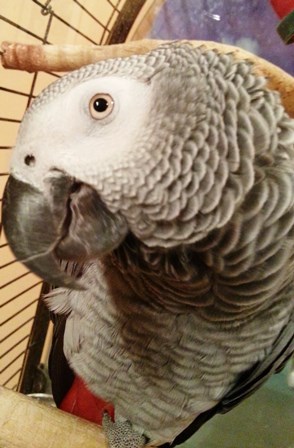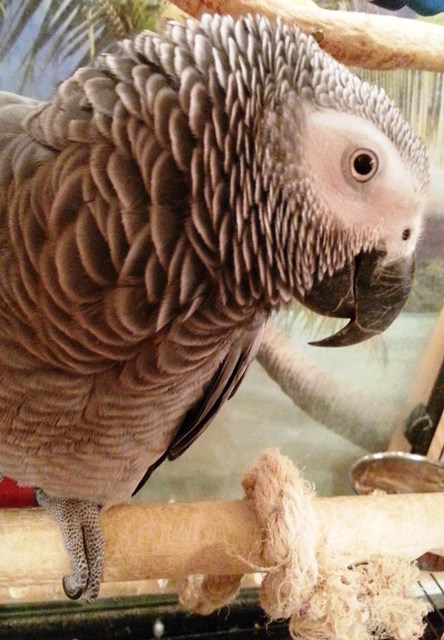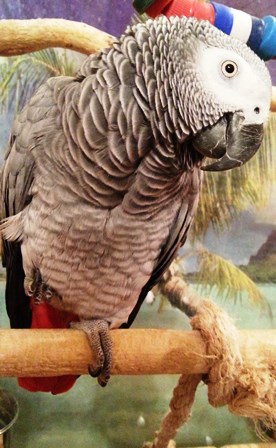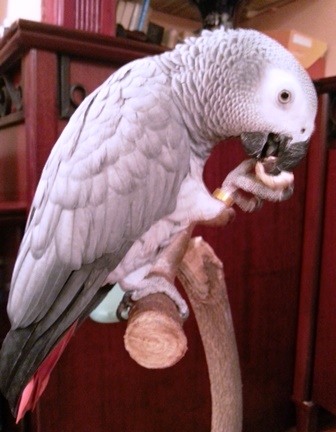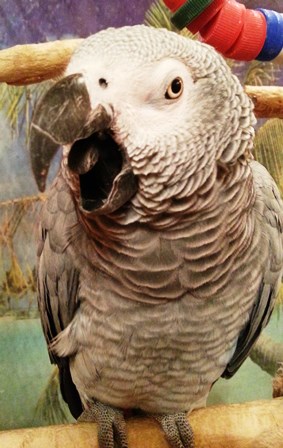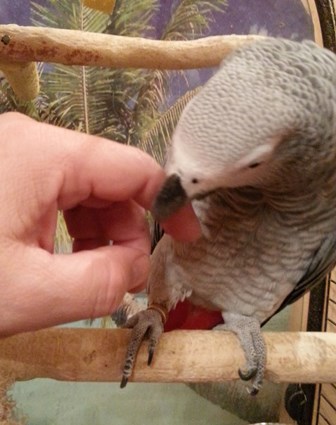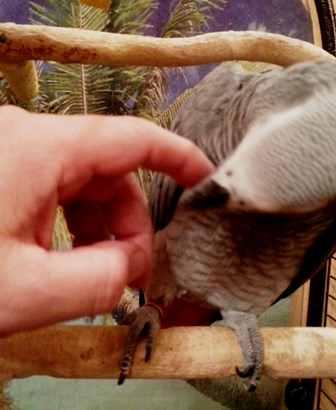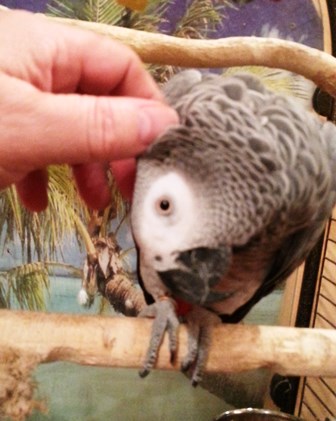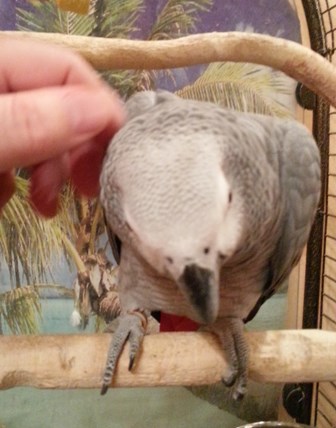NEW ADDRESS FOR MEMBERS GREYFORUMS.ORG
-
Posts
124 -
Joined
-
Last visited
Content Type
Profiles
Forums
Events
Gallery
Everything posted by MKparrot
-
If you happen to find yourself in London (UK) particularly in Kingston Upon Thames, Richmond, Twickenham, or some areas of South London such as Catford and parts of Battersea, you may find yourself face to face with a parrots. It comes as a surprise to most people who are not local to London to learn that London plays host to several large and thriving colonies of feral parrots, which can easily be seen and heard in several areas of the city, particularly during the summer months. While there are a couple of different species of parrots living wild in pockets of land across the city, the largest colonies of most commonly seen wild London parrots are feral rose-ringed parakeets. Monk parakeets are another species that is growing exponentially in amongst the native wildlife of London, being similar in appearance to the rose-ringed parakeet but with a white chest and slightly sturdier build. Parakeets build large nests and live mainly in trees and high bushes. There is some debate as to how non-native parrots came to settle and reproduce in significant enough numbers to form entire colonies within the city, and the total number of wild rose-ringed parakeets living in London is now estimated to be well over 10,000 individual birds. Parrot colonies have only resided in London in significant numbers since the 1990’s, and various theories have been put forward to explain their presence. It is generally accepted that just one single breeding pair of rose-ringed parakeets being released into the wild could have formed the basis of the existing London parakeet colonies. It has also been suggested that a flock of the birds escaped from London’s Ealing studios during filming, that a container of the birds fell open at Heathrow airport, and that a large aviary collapsed during the storms of 1987, releasing a significant number of the birds into the surrounding area. The exact origins of monk parakeet colonies in London and the Home Counties are less widely conjectured, although again, just one single breeding pair could have been enough to form the basis of the wild monk parakeet population that is now some 200 birds strong! Particularly long, cold winters tend to have a natural culling effect on the wild parrot populations of London, although for birds of tropical origins, they are surprisingly hardy and generally quite capable of weathering the British cold. Wild parrots eat berries, seeds, nuts, buds, vegetables and fruit, and are often credited with decimating entire orchards and gardens within just a few weeks. Many gardeners and fans of native wildlife are unhappy with the presence of these undoubtedly beautiful and striking birds, due to the effect they have on the natural ecosystem and native bird population of the area. Deliberately or accidentally introducing a non-native species such as parakeets into the existing ecosystem of an area generally has a negative effect on the existing native species, and the presence of the London parakeets is no exception. The London parakeets are widely accepted to eat plants, fruit and food from bird tables that is provided for native birds, often starving smaller native species out of the area. Rose-ringed parakeets are currently subject to agricultural controls in order to cap their numbers and the effect they have upon the environment, and DEFRA (Department for the Environment, Food and Rural Affairs) has already announced plans to instigate similar control and culling measures on the monk parakeet population before they too, breed out of control. Find out more on London parrots here I know of many examples of feral parrots across the world (no Grays on the list), but can you point out any that is actually in your city/country?
-
Nice bird - nice pics !
-
How is your Grey doing? My Poly fell of perch 2 times while sleeping. It happen all the times with many birds in nature and in captivity....but you may not take your Grey out of cage immediately. Wait for a while and let him climb back on his own. Act only if he is laying in unnatural position and not moving.
-
Thanks for your kind words...but actually, the "story" behind this photo is rather prosaic - Poly yawns because he feel asleep and he made it clear that the photo session is over
-
-
Here is Poly, my 3 year old Grey. Born on September 09, 2010 in Serbia, to international parents couple (he is half Serbian on hid father's side and half Hungarian on his mother's side) and now being himself citizen of Macedonia... He is single - so far;) International brides are welcome:o He is so cute and quite a charmer - none can resist him:)
-

MOMENTS OF TENDERNESS; bonding with my CAG ...
MKparrot replied to Grumpy's topic in The GREY Lounge
When Polly wants to enjoy itching - my hand is getting tired........... it takes a long, long, long time..... he is enjoying and do not let me stop even for a while. Here are pics...note how he took my finger back on his neck to keep me itching him:) -
Ohhhhhh holidays, holidays ...at the end of the day it comes down to gathering at the table and overeating:) Nice pics though and nice parrot bunch:D
-
Do parrots have a sense of smell? Certainly the physical evidence shows they don’t have a lot of receptors for scent i.e. they have an underdeveloped sense of smell. Smells dissolve rather quickly in the air. Because parrots/birds spend most of their time in the air, this may be the reason why it is assumed that birds have a poor sense of smell. There is scientific evidence that some New Zealand parrot species have very keen sense of smell and use it very often (unlike other parrots). Do Greys use their smell sense (even it is underdeveloped )? Any thoughts? :confused:
-
Do parrots have REM sleep as mammals do? Yes. According to research at the University of Chicago, not only parrots but all birds do dream. They dream about their vocalization, songs, have dream rehearsals, and sing the same songs better the next day. Greys do talk/mutter in their sleep sometimes and sometimes perform new tricks and words next day better than previous day. What do you think of this? Your experiences with your Greys dreaming?
-
Lancashire Telegraph, on November 08th, 2011 reported about Sam's (CAG) heroic act in Darwen, UK: Mimicking his owner Suzanna Bolton’s voice, 18-year-old African Grey parrot Sam squawked a distress call in her ear after going upstairs and jumping onto her bed in the dead of the night. Sam woke Suzanna with calls to ‘come on, come on’ before leading her to the pups. Mrs Bolton’s four-year-old Pomeranian bitch Sally had gone into labor a week early and both she and her puppies were in distress on a cold and wet kitchen floor. Mrs Bolton said: “Sam is allowed to roam around out of his cage, but parrots are not known to move at night. That night he seemed to know what was going on and came looking for me to help.He’s never been in my bedroom before in the eight years I’ve had him, but he came up the stairs, climbed on the bed and started talking to me in my own voice with the words “come on, come on”, which I often say to Sally. I wondered what on earth was going on and took Sam back downstairs to his perch, but then he looked at me and squawked. It was then I looked in the kitchen and saw the puppies. One had died and the other five boys were all very, very cold and wet. I quickly got the heat pads out for them and got them next to a radiator, and luckily they’re now doing well. I honestly believe that if Sam hadn’t have acted how he did, then the others could have died too during the night.” Do you know of another heroic act of Greys? If yes, share it with other forum members, please.
-
I don't know if many of you know traditional Yoruba legend about Greys. In many west and west-central African cultures, the African grey parrot is considered sacred. According to a legend from the Yoruba people (of South Western Nigeria, the Republic of Benin, the Republic of Togo and Ghana), the African grey parrot which is known as Odide was not always grey, nor did it always have red tail feathers. God decided to have a contest to see which bird had the most beautiful feathers so all the birds in the world began preparing themselves. They sought to improve their beauty by adding things to themselves or trying to enhance their colors. At that time the Odide, which was white in color, made no preparations at all. This caused the other birds to wonder, why were they working so hard and why Odide was doing nothing at all. All of the other birds began to worry. They were afraid that if Odide entered the contest they would all lose. So, all the other birds got together and decided to spoil Odide's natural beauty. They first tried to spoil Odide's beauty by dumping ashes on it as it flew through the trees. This did not seem to have any effect. Next the other birds went to the Sorcerer to get an evil charm which would turn the Odide's tail feathers red. The other birds were quite sure that the Odide would not enter the contest now, since they had spoiled its natural beauty. On the day of the beauty contest the Odide entered any way in spite of all that had been done to it. Much to the surprise of the other birds, God awarded the prize to the Odide because it came to the contest even though so much harm had been done to it. God said that the Odide was indeed the most beautiful bird, because true beauty is on the inside. In many west and west central African cultures the African grey parrot is considered sacred and its tail feathers are a symbol of or an emblem of royalty. When Kings and Queens are crowned and members of the priesthood ordained at least one tail feather from the African grey must either be in the crown or some where on the person being crowned or ordained. This is done to remind them that true beauty comes from within.
-
As I am aware, the hypothesis that Greys need more calcium than other birds is still up for debate, but nevertheless, many pet owners find themselves in the veterinarian’s office with a diagnosis of low calcium in the blood, which can lead to seizures and other medical complications. Some avian vets claim that “The most common medical problem associated with African Greys is hypocalcemia" It is considered more common than feather picking, respiratory disease and malnutrition. Greys seem to need more calcium than some other species, but calcium alone is not enough. It takes a number of other nutrients to properly absorb the calcium, such as magnesium, boron, vitamins C, D, and K, which are all part of the calcium complex. Veterinarians are giving seizure-Greys calcium shots, with no results until the other parts of the complex, especially magnesium, is given. I have been advised not to give calcium, or any other dietary supplements, to my bird unless otherwise prescribed by the vet. My bird does not have any problem that may be related to calcium and he has regular diet rich in calcium, vitamin C, D, K and magnesium. I just want to share some info of the above: Greys need more calcium than other parrots- True or Myth? :confused:
-
Based on scientific tests over five decades, government safety agencies have determined that polystyrene is safe for use in food-service products. For example, polystyrene meets the standards of the U.S. Food and Drug Administration and the European Commission/European Food Safety Authority for use in packaging to store and serve food. Polystyrene is common container for food and drinks. The styrene monomer (from which polystyrene is made) is a cancer suspect agent; it is "generally found in such low levels in consumer products that risks are low". Styrene in food or water can rapidly enter the body through the digestive tract and most of these chemicals are excreted in urine within a few days. Styrene is highly metabolized in humans, with an estimated 97% eliminated through metabolic pathways, Although its effects on humans and aquatic life have been studied, the data on short- or long-term exposures to plants, birds, and land animals are insufficient to be conclusive. Styrene oligomers in polystyrene containers used for food packaging have been found to migrate into the food. Japanese study conducted on wild-type and AhR-null mice found that the styrene trimmer, which the authors detected in cooked polystyrene container-packed instant foods, may increase thyroid hormone levels. So, if bird would chew the Styrofoam food containers often there is potential risk of intoxication. …not to mention the risk of suffocation. My opinion is that it is wise not to give our parrots styrene containers and toys to play with and to chew them.
-
Michael Sazhin (The Parrot Wizard) and his Kili and Truman are well-known in the entertainment world. Michael's training achievements seems respectful and there is no doubt that you can learn a lot on parrot training and behavior. BUT, do not get too excited and do not have too high expectations on YOUR results with your parrot. Always keep in mind that trained birds (I mean those that are kept and "employed" as "entertainers" and "show birds") do not live as your parrot (or mine or everyone's else). Our birds are pets and companions. Trained "entertainment birds" are money-makers (on TV shows, in ZOO gardens,etc...) They have every day repetitive training sessions (hundreds of them) and they have trained mind and behavior setup that you can not achieve at home with your bird. So, yes - books, videos, tricks and tips are OK, just don't compare your parrot's achievements with those on TV.
-
I keep on trying occasionally with baklava metal pan but Poly just wet his feet in it and than walk out. Maybe he don't like baklava and bathing in pan is odious to him
-
I am glad that Cockey is OK. I have had similar experience with Poly more than a year ago. Since then no laces are allowed. I do not hang toys or anything on laces in and around the cage. I use chains only with appropriate links size and I avoid hanging parts that may swing and swirl up and get around birds neck or leg. And yes - be sure that ALWAYS you will have a pair of scissors and pliers in a close range. By the way - welcome to the "Parrot bite me club":D
-
Nine week old CAG CAN NOT chew their feathers. It is not unusual that baby CAG would have some spots with less feathers, especially around the neck.
-
Yes I agree with judygram. I am memeber of another (UK based) forum but it is not the same feeling. There is a strong comunity like feeling here...and I like it.
-
Nancy, it seems to me that you have to make reasonable compromise. It is not about dogs and parrots - it is all about your Ryan. You will sacrifice your (and your parrot's) comfort for a while. Sophie's room will be closed part time and part time the dog will be crate. Ryan will watch over his dog (probably the dog will be limping and lying, not running around, most the time while recovery) you will watch over Sophie and most off all you will enjoy Ryan's presence that seems you love so much. Chin up Nancy, don't worry - be happy for Ryan's presence at your home :):)
-
No sleep tent for Poly either. What's the purpose? Every evening his cage is covered as soon as he ask for it. When he wants to sleep he just go to his favorite perch and say"Ciao". If I ignore him he will say "Ciao" again and if I do not respond he will send me one of his irritating screams. While covering the cage we exchange one or two "goodnight"s and that is all. No sleep tent, no sleep huts... What is the purpose of sleep tent if you cover the cage and especially if your bird has sleeping cage in a separate room?




